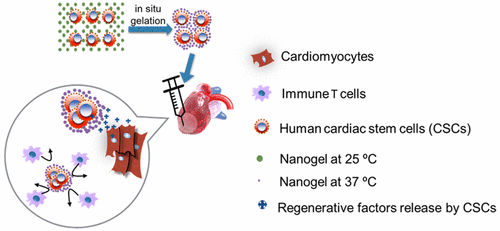Our official English website, www.x-mol.net, welcomes your
feedback! (Note: you will need to create a separate account there.)
Heart Repair Using Nanogel-Encapsulated Human Cardiac Stem Cells in Mice and Pigs with Myocardial Infarction
ACS Nano ( IF 15.8 ) Pub Date : 2017-09-20 00:00:00 , DOI: 10.1021/acsnano.7b01008 Junnan Tang 1, 2, 3 , Xiaolin Cui 4 , Thomas G Caranasos 5 , M Taylor Hensley 2, 3 , Adam C Vandergriff 2, 3 , Yusak Hartanto 4 , Deliang Shen 1 , Hu Zhang 4 , Jinying Zhang 1 , Ke Cheng 2, 3, 6
ACS Nano ( IF 15.8 ) Pub Date : 2017-09-20 00:00:00 , DOI: 10.1021/acsnano.7b01008 Junnan Tang 1, 2, 3 , Xiaolin Cui 4 , Thomas G Caranasos 5 , M Taylor Hensley 2, 3 , Adam C Vandergriff 2, 3 , Yusak Hartanto 4 , Deliang Shen 1 , Hu Zhang 4 , Jinying Zhang 1 , Ke Cheng 2, 3, 6
Affiliation

|
Stem cell transplantation is currently implemented clinically but is limited by low retention and engraftment of transplanted cells and the adverse effects of inflammation and immunoreaction when allogeneic or xenogeneic cells are used. Here, we demonstrate the safety and efficacy of encapsulating human cardiac stem cells (hCSCs) in thermosensitive poly(N-isopropylacrylamine-co-acrylic acid) or P(NIPAM-AA) nanogel in mouse and pig models of myocardial infarction (MI). Unlike xenogeneic hCSCs injected in saline, injection of nanogel-encapsulated hCSCs does not elicit systemic inflammation or local T cell infiltrations in immunocompetent mice. In mice and pigs with acute MI, injection of encapsulated hCSCs preserves cardiac function and reduces scar sizes, whereas injection of hCSCs in saline has an adverse effect on heart healing. In conclusion, thermosensitive nanogels can be used as a stem cell carrier: the porous and convoluted inner structure allows nutrient, oxygen, and secretion diffusion but can prevent the stem cells from being attacked by immune cells.
中文翻译:

使用纳米凝胶封装的人类心脏干细胞修复患有心肌梗塞的小鼠和猪的心脏
干细胞移植目前已在临床上实施,但由于移植细胞的保留和植入率低以及使用同种异体或异种细胞时炎症和免疫反应的不利影响而受到限制。在这里,我们在小鼠和猪的心肌梗死(MI)模型中证明了将人类心脏干细胞(hCSC)封装在热敏聚( N-异丙基丙烯胺-丙烯酸)或P(NIPAM-AA)纳米凝胶中的安全性和有效性。与注射盐水中的异种 hCSC 不同,注射纳米凝胶封装的 hCSC 不会在免疫功能正常的小鼠中引起全身炎症或局部 T 细胞浸润。在患有急性心肌梗死的小鼠和猪中,注射封装的 hCSC 可保留心脏功能并减少疤痕大小,而注射盐水中的 hCSC 对心脏愈合有不利影响。总之,热敏纳米凝胶可以用作干细胞载体:多孔且卷曲的内部结构允许营养物质、氧气和分泌物扩散,但可以防止干细胞受到免疫细胞的攻击。
更新日期:2017-09-20
中文翻译:

使用纳米凝胶封装的人类心脏干细胞修复患有心肌梗塞的小鼠和猪的心脏
干细胞移植目前已在临床上实施,但由于移植细胞的保留和植入率低以及使用同种异体或异种细胞时炎症和免疫反应的不利影响而受到限制。在这里,我们在小鼠和猪的心肌梗死(MI)模型中证明了将人类心脏干细胞(hCSC)封装在热敏聚( N-异丙基丙烯胺-丙烯酸)或P(NIPAM-AA)纳米凝胶中的安全性和有效性。与注射盐水中的异种 hCSC 不同,注射纳米凝胶封装的 hCSC 不会在免疫功能正常的小鼠中引起全身炎症或局部 T 细胞浸润。在患有急性心肌梗死的小鼠和猪中,注射封装的 hCSC 可保留心脏功能并减少疤痕大小,而注射盐水中的 hCSC 对心脏愈合有不利影响。总之,热敏纳米凝胶可以用作干细胞载体:多孔且卷曲的内部结构允许营养物质、氧气和分泌物扩散,但可以防止干细胞受到免疫细胞的攻击。











































 京公网安备 11010802027423号
京公网安备 11010802027423号